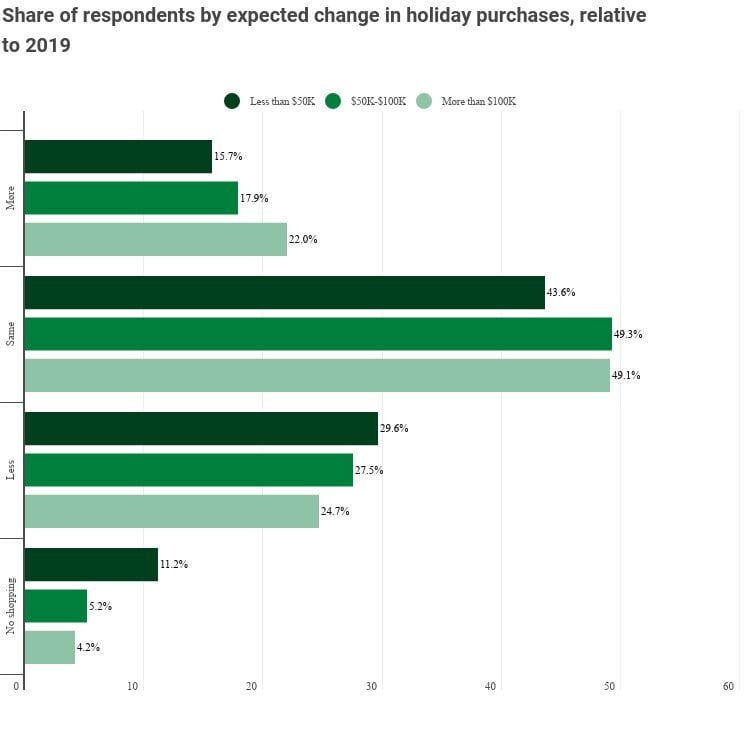Retail Data Shows Online Dominance, Gift Card Momentum For Holiday Spending

While predictions of increased spending are appearing more frequently since news of various COVID-19 vaccines has broken, PYMNTS data shows that consumers are still cautious, conservative and digital-first when it comes to holiday 2020.
According to an exclusive consumer survey, 27 percent of shoppers expect to spend less money than they did in 2019. About 47 percent said they were expecting to spend about the same as last year, and only 18.7 percent said they planned to spend more. Seven percent said they planned to avoid holiday shopping altogether.
The lower end of the shopping intent is split along income and demographic lines. Among those who said they would shop more, 22 percent had income of more than $100,000; for those who would shop less, 29.6 percent made less than $50,000 and 27 percent made between $50,000 and $100,000. Surprisingly, the cohorts who said they would shop about the same were split evenly along income lines.
When it comes to “no shopping,” 11.2 percent made less than $50,000, indicating that the population segments that live paycheck to paycheck are having a hard time making ends meet enough to spend on the holiday. There’s a certain amount of “bah humbug” at play as well. Baby boomers and seniors doubled other income brackets in the share of respondents who will not shop. Among those who said they would increase spend, about a third of millennials and Gen Xers said they would increase spending. Only 6.9 percent of seniors and baby boomers said they would spend more.
 And when they do spend, consumers will do so online – some of them exclusively. A stunning 96.5 percent of holiday shoppers said they would make an eCommerce purchase, while 17.5 percent said they would do all of their shopping online.
And when they do spend, consumers will do so online – some of them exclusively. A stunning 96.5 percent of holiday shoppers said they would make an eCommerce purchase, while 17.5 percent said they would do all of their shopping online.
The conduit to that spend is split between desktop and mobile devices. Seventy-four percent of holiday shoppers will do so via mobile device; 91.3 percent will use a laptop or PC. A third of bridge millennials will increase their usage of mobile devices, more than any other segment. And again, the mobile laggards are baby boomers and seniors: 46 percent said they would not use mobile devices.
And when consumers do go online, gift cards are winning the season. The range of responses extends fairly evenly on this point. When asked if they would purchase gift cards as part of their online shopping for the holidays, 29.6 percent were either very or extremely likely to do so. Almost the exact same amount said they were “somewhat likely” to purchase a gift card. About 41 percent said they were only slightly likely or not at all likely to purchase gift cards. Again, bridge millennials and Gen Xers led the way, with 35.7 and 34.7 percent likelihood to purchase gift cards, respectively.
 Previous PYMNTS research shows that payments play a big role. When asked which digital offerings will impact their willingness to shop in stores, consumers said they are particularly interested in using contactless payment options – 26 percent and 23 percent of consumers say merchants must accept contactless cards and offer curbside pickup, respectively, for them to feel comfortable shopping in a store. This underscores a widespread desire to avoid more traditional in-store payment options, such as cash or cards, which require consumers to make physical contact with paper bills and POS terminals.
Previous PYMNTS research shows that payments play a big role. When asked which digital offerings will impact their willingness to shop in stores, consumers said they are particularly interested in using contactless payment options – 26 percent and 23 percent of consumers say merchants must accept contactless cards and offer curbside pickup, respectively, for them to feel comfortable shopping in a store. This underscores a widespread desire to avoid more traditional in-store payment options, such as cash or cards, which require consumers to make physical contact with paper bills and POS terminals.
As stated earlier, some projections are more optimistic. For example, the International Council of Shopping Centers says 85 percent of consumers expect to shop in the period beginning Thanksgiving and ending Cyber Monday. On average, consumers are projected to spend $470 on holiday items and 44 percent expect to spend more than they did last year. ICSC’s research reveals a swell of interest in omnichannel formats, a sign that retailers capable of meeting demand both online and in-person will be best positioned for success in this unprecedented holiday season.
“ICSC is forecasting a solid holiday season with 1.9 percent growth year over year,” said Tom McGee, president and CEO of ICSC. “This holiday season will be longer for a variety of reasons, including retailers encouraging shoppers to get out earlier. As a result, you’ll see a continuation of the trends that have accelerated over the course of the last number of the months due to the pandemic.”
